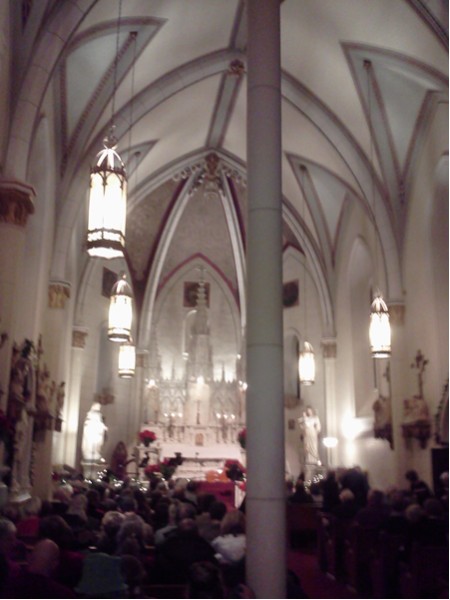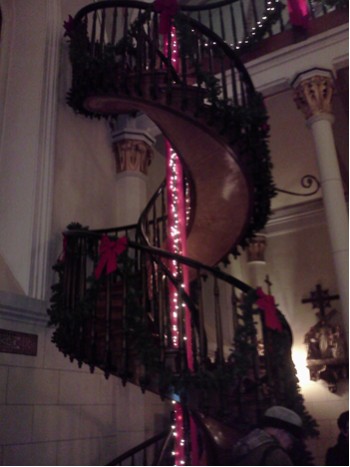Miraculous
by wjw on December 23, 2011
 Behold my photo of Santa Fe’s Loretto Chapel, where we attended Pro Musica’s annual Baroque Christmas Concert the other night. The chapel was built by the Sisters of Loretto, who came to Santa Fe in the 1850s and ran an orphanage and hospital until 1968, after which the chapel was de-sanctified and is now a private museum that you can rent for weddings and other functions.
Behold my photo of Santa Fe’s Loretto Chapel, where we attended Pro Musica’s annual Baroque Christmas Concert the other night. The chapel was built by the Sisters of Loretto, who came to Santa Fe in the 1850s and ran an orphanage and hospital until 1968, after which the chapel was de-sanctified and is now a private museum that you can rent for weddings and other functions.
The Sisters arrived at the request of Archbishop Jean-Baptiste Lamy, the aristocratic Frenchman who is the central figure in Willa Cather’s Death Comes for the Archbishop. Lamy arrived shortly after the Mexican-American War and was appalled by the provincialism he found in his diocese. “Zut!” he must have said to himself. “The cathedral it is made of mud bricks! We must initiate the mission civilisatrice!“
The letter he wrote to a colleague complaining that he was pastor to “300,000 Catholics and 300 Americans” is probably a good indicator of his cultural attitudes.
So Lamy refused to allow any New Mexican to be born, married, or die without paying a substantial tax to the church. (It’s not kosher to charge for the sacraments, but this was la crise extraordinaire. The dignity of the archbishop was at stake!) Despite the hardship Lamy inflicted on his flock, the resistance from local clergy, and more resistance from the Penitentes (who Lamy tried to suppress), the adobe cathedral was torn down and a stone cathedral built in its place. Lamy even imported a French architect to make sure the job was done right.
Loretto Chapel was designed by the same architect, and its soaring Gothic style is meant to invoke Ste.-Chapelle in Paris. The glass windows were even brought from France! Anyone who has actually seen Ste.-Chapelle would probably find Loretto a pale imitation at best, but when all is said and done, it’s pretty impressive for New Mexico in the 1870s.
Since the architect died during the course of construction, it was discovered too late that the plans failed to include a way to get into the choir loft. The nuns were forced to climb up and down a ladder, allowing impious children to look up their skirts! Yet there was no room for a proper stair. What to do?
So the nuns prayed for nine straight days, and God sent St. Joseph, the putative father of Jesus, to build the “miraculous staircase” you see in my second photo. (Spoilsports claim that the stair was actually built by one Francois-Jean “Frenchy” Rochas, a French woodworker who was later murdered.) It’s a more unusual structure than my photograph shows— it’s completely cantilevered, with no central pole to stabilize it. (The object in the photo that looks like a central pole is actually a red holiday banner that furnishes no structural support.)
Apparently you’re not allowed on the stair any longer, but I climbed it back when it was permitted, and it was far from a stable— there was a lot of spring and sway in it. I’ve heard stories of nuns climbing down on hands and knees.
And the concert? It was pretty darn fine, and featured works by Handel, Boismortier, Vivaldi, and Janitsch, with a selection of Christmas carols, the most recent of which dates from the 17th Century. Loretto Chapel is made for sopranos, and soprano Liesl Odenweller was made for the Chapel. I would have been completely transported, except that my pew was so damned uncomfortable that I spent the latter part of the concert praying either for the finale or for death. Next time I’ll bring a cushion.

 Behold my photo of Santa Fe’s Loretto Chapel, where we attended Pro Musica’s annual Baroque Christmas Concert the other night. The chapel was built by the Sisters of Loretto, who came to Santa Fe in the 1850s and ran an orphanage and hospital until 1968, after which the chapel was de-sanctified and is now a private museum that you can rent for weddings and other functions.
Behold my photo of Santa Fe’s Loretto Chapel, where we attended Pro Musica’s annual Baroque Christmas Concert the other night. The chapel was built by the Sisters of Loretto, who came to Santa Fe in the 1850s and ran an orphanage and hospital until 1968, after which the chapel was de-sanctified and is now a private museum that you can rent for weddings and other functions.
“I spent the latter part of the concert praying either for the finale or for death.”
Death comes for the arch writer?
Comments on this entry are closed.